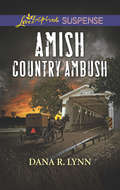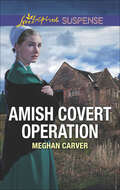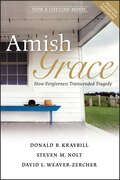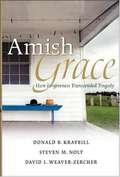- Table View
- List View
Amish Cooks Across America: Recipes and Traditions from Maine to Montana
by Kevin Williams Lovina EicherA culinary tour of Amish America with photos, stories, and recipes for Shoofly Pie and much more—from a wide range of unique communities.In this blend of recipe book and travelogue, the celebrated columnist and cookbook author known as The Amish Cook explores why one Amish community in the Northeast makes Shoofly Pie while another settlement in the South favors Muscadine Pie. Divided into chapters highlighting Amish groups in the North, South, East, West, and Midwest, with side trips to Canada and Central America, this it provides a sample of the cultural and culinary differences among Amish and Mennonite communities across the nation.The Amish are the original locavores. In this collection of fascinating recipes, you’ll find favorites from middle America, such as Scalloped Corn, alongside coastal specialties including Grilled Lime Fish Fillets and Avocado Egg Scramble, as well as Western staples like Elk Stew and Huckleberry Pancakes and Southern classics such as Sweet Potato Surprise Cake.This more-than-a-cookbook is filled with full-color photographs of food and the places visited, along with profiles that explore the origins and cooking traditions of each community. This is a book like no other—a delicious melting pot and a fascinating armchair tour of Amish America.
Amish Cooks Across America: Recipes and Traditions from Maine to Montana
by Kevin Williams Lovina EicherA culinary tour of Amish America with photos, stories, and recipes for Shoofly Pie and much more—from a wide range of unique communities.In this blend of recipe book and travelogue, the celebrated columnist and cookbook author known as The Amish Cook explores why one Amish community in the Northeast makes Shoofly Pie while another settlement in the South favors Muscadine Pie. Divided into chapters highlighting Amish groups in the North, South, East, West, and Midwest, with side trips to Canada and Central America, this it provides a sample of the cultural and culinary differences among Amish and Mennonite communities across the nation.The Amish are the original locavores. In this collection of fascinating recipes, you’ll find favorites from middle America, such as Scalloped Corn, alongside coastal specialties including Grilled Lime Fish Fillets and Avocado Egg Scramble, as well as Western staples like Elk Stew and Huckleberry Pancakes and Southern classics such as Sweet Potato Surprise Cake.This more-than-a-cookbook is filled with full-color photographs of food and the places visited, along with profiles that explore the origins and cooking traditions of each community. This is a book like no other—a delicious melting pot and a fascinating armchair tour of Amish America.
Amish Country Ambush: Rescue Operation Amish Country Ambush Accidental Eyewitness (Amish Country Justice)
by Dana R. LynnHidden in Plain SightAn Amish Country Justice storyAfter police dispatcher Elise St. Clair’s home is invaded by her murderous brother-in-law, her nephew is hidden in Amish Country by her cleaning lady. Now relying on police officer Ryan Parker is Elise’s only hope of reuniting with the child…and evading the killer. And Elise and Ryan quickly discover their temporary partnership has long-term potential—if they can stay alive.
Amish Country Amnesia: Runaway Amish Bride Amish Country Amnesia
by Meghan CarverWhen an undercover cop loses his memory, a young Amish widow may be his only chance at survival in this inspiring romantic suspense novel.After a year of high stakes undercover work, Jed Miller is set to testify against a dangerous criminal organization . . . until they track him down in northern Indiana. Speeding away from them on a snowmobile, he barely escapes with his life. But an accident leaves him severely injured.When Amish widow Sarah Burkholder and her young daughter come across an injured stranger, they are determined to help him recover his health—and his memory. Even as Sarah’s feelings for him grow, they discover unknown assailants are after him. Now Sarah and her little girl are targeted for helping him. But if Jed can remember who he is, he might just save all their lives.
Amish Country Box Set
by Marta Perry Patricia Davids Emma MillerTake a trip through the Amish countryside and fall in love with these three sweet tales of Amish romance.While searching for her Amish roots in Pennsylvania Dutch country, a young nurse falls for the dashing local police chief. The new doctor in town clashes with the Amish community's trusted midwife until they realize agree on what's truly important. A sensible young Amish woman must choose between family obligations and the love of a handsome newcomer with a bad reputation. If you love Beverly Lewis and Wanda Brunstetter, then you'll love these Amish books from Love Inspired. Three heartwarming books, one great price.This bundle includes:RESTLESS HEARTS by Marta PerryTHE DOCTOR'S BLESSING by Patricia DavidsCOURTING RUTH by Emma Miller
Amish Country Cover-Up
by Alison StoneSomeone wants her dead…But is it tied to another murder?When Amish nanny Liddie Miller is attacked more than once while caring for Jonah Troyer’s children, the attempts stir up too many memories of his wife’s murder for comfort. Though the police insist the murderer died in prison, Jonah’s convinced there’s a connection. And he won’t let another woman die on his watch. He just has to figure out the culprit’s motives…before it’s too late.From Harlequin Love Inspired Suspense: Courage. Danger. Faith.
Amish Country Hideout
by Alison Stone Mary AlfordIn these two inspirational romantic suspense novels, women seeking refuge in Amish country find the protection and love of good men. Shielding the Amish Witness by USA Today bestselling author Mary AlfordOn the run after discovering her brother-in-law was behind her husband’s murder, Faith Cooper can think of only one safe place—her Amish grandmother’s home. But when danger follows Faith to the quiet Amish community, her childhood friend Eli Shetler is her only protection. And their survival depends on outlasting a relentless killer…one who has nothing left to lose.Seeking Amish Shelter by Alison StoneStumbling upon illegal drug activity in the health-care clinic where she works thrusts nursing student Bridget Miller into the crosshairs of a violent criminal. Now under the protection of DEA agent Zachary Bryant, she has no choice but to hide in her family’s Amish community. Reentering the life she abandoned to chase her dreams isn’t easy, but it may be the only way to stay alive…
Amish Country Kidnapping (Mills And Boon Love Inspired Suspense Ser.)
by Mary AlfordAn Amish widow and a sheriff’s deputy must rescue her sister from a killer in this inspirational romantic suspense mystery by a USA Today bestseller.Waking up to a man trying to kidnap her is Amish widow Rachel Albrecht’s most terrifying moment—until she discovers he’s already taken her teenaged sister. Now Rachel’s life—and her sister’s—depends on her first love, Englischer deputy Noah Warren. But the danger of rekindling their forbidden love is the least of Rachel’s worries with her family in a killer’s sights . . .
Amish Country Kidnapping and Amish Country Undercover
by Katy Lee Mary AlfordSecrets and danger in Amish country in two great inspirational romantic suspense novels, together for the price of one.Amish Country Kidnapping by USA Today–bestselling author Mary AlfordWaking up to a man trying to kidnap her is Amish widow Rachel Albrecht’s most terrifying moment—until she discovers he’s already taken her teenaged sister. Now Rachel’s life—and her sister’s—depends on her first love, Englischer deputy Noah Warren. But the danger of rekindling their forbidden love is the least of Rachel’s worries with her family in a killer’s sights . . .Amish Country Undercover by Katy LeeTaking the reins of her father’s Amish horse-trading business, Grace Miller’s prepared for backlash over breaking community norms—but not for sabotage. Now someone’s willing to do anything it takes to make sure she fails, and it’s undercover FBI agent Jack Kaufman’s mission to stop them. But can Jack face his own Amish past long enough to shield Grace from a killer?
Amish Country Killer
by Mary AlfordAn unsolved mystery… Seeking the truth could be fatal. Reopening the investigation of her mother's disappearance puts chief of police Diana Fisher in someone&’s lethal sights. As she delves deeper into the mystery, a murderer resurfaces, targeting the Amish community. Detective Micah Nissley, whose fiancée went missing a decade ago, joins forces with Diana to stop the threats and bring the killer to justice. But can they uncover the connection between Diana and the culprit before she becomes the next victim?From Love Inspired Suspense: Courage. Danger. Faith.
Amish Country Murder
by Mary AlfordAn FBI agent needs an Amish woman’s help to find a serial killer in this inspirational romantic suspense tale by a USA Today–bestselling author.As the sole woman to escape the Dead of Night Killer, Catherine Fisher’s the key to catching him—if he doesn’t kill her first. Now it’s up to FBI agent Sutter Brenneman to protect her. But with her memory missing and all clues indicating the serial killer took her for very personal reasons, it’ll take everything Sutter has to keep her safe.
Amish Country Ransom
by Mary AlfordA winter storm turns a fight for justice into a struggle for survival… After FBI agent Jade Powell&’s sister is abducted, K-9 trainer Ethan Connors is determined to help the woman who once saved his life. But an enemy from Jade&’s past will stop at nothing to keep his agenda hidden. With a storm brewing and a killer hunting them deep into Amish country, can Jade and Ethan survive the treacherous weather long enough to bring a criminal mastermind to justice?From Love Inspired Suspense: Courage. Danger. Faith.
Amish Country Secret
by Lenora WorthThis murder witness is returning home…With a secret someone wants to bury.With a hit out on her life, Samantha Herndon escapes to the one place she knows she’ll be safe—her Amish grandmother’s empty home. But when a tornado flings her car into Micah King’s field, her plans for solitary refuge end. The Amish bachelor knows the Englischer is trouble, but he’s falling for her anyway. Can Micah keep Samantha alive…and convince her to stay?New York Times bestselling author Lenora WorthFrom Harlequin Love Inspired Suspense: Courage. Danger. Faith.
Amish Country Threats (Amish Country Justice #10)
by Dana R. LynnHer brother was murdered.Will she be next?While searching for proof that her brother’s death was no accident, Lilah Schwartz is almost killed by a sniper in her Amish community. Hiding in Levi Burkholder’s barn is all that keeps her alive. The former soldier will do everything in his power to protect Lilah, but can he and Lilah uncover the evidence her brother hid before she’s the next to die?From Love Inspired Suspense: Courage. Danger. Faith.Amish Country JusticeBook 1: Plain TargetBook 2: Plain RetributionBook 3: Amish Christmas AbductionBook 4: Amish Country AmbushBook 5: Amish Christmas EmergencyBook 6: Guarding the Amish MidwifeBook 7: Hidden in Amish CountryBook 8: Plain RefugeBook 9: Deadly Amish ReunionBook 10: Amish Country Threats
Amish Country Undercover
by Katy LeeAn FBI agent springs into action when an Amish woman’s life is in danger in this inspirational romantic suspense thriller.Taking the reins of her father’s Amish horse-trading business, Grace Miller’s prepared for backlash over breaking community norms—but not for sabotage. Now someone’s willing to do anything it takes to make sure she fails, and it’s undercover FBI agent Jack Kaufman’s mission to stop them. But can Jack face his own Amish past long enough to shield Grace from a killer?
Amish Covert Operation: An Anthology (Love Insp Susp True Lp Trade Ser.)
by Meghan CarverAn eyewitness to a crime, an Amish single mom goes under the protection of an undercover agent.After Amish widow Katie Schwartz’s search for her missing brother results in a shooting and her finding a cryptic message, she must rely on federal agent Adam Troyer to shield her. But, undercover as a Plain man, can Adam save her brother’s life and protect Katie? Trusting the handsome Englisch agent is already dangerous…but falling for him could risk everything Katie holds dear.
Amish Cradle Conspiracy (Amish Country Justice #13)
by Dana R. LynnFrom USA TODAY bestselling author Dana R. Lynn. To protect an Amish community… She&’ll make herself a target. After a pregnant Amish woman and her toddler are abducted, police sergeant Nicole Dawson charges in to save them. But when the kidnapper escapes with the child—and thinks Nicole can identify him—she becomes his new obsession. Determined to protect his ex-fiancée, FBI special agent Jack Quinn joins the case. But the clock is ticking in their race to uncover the baby-trafficking ring before another innocent is taken…From Love Inspired Suspense: Courage. Danger. Faith. AN AMISH COUNTRY JUSTICE THRILLER Book 1: Plain TargetBook 2: Plain RetributionBook 3: Amish Christmas AbductionBook 4: Amish Country AmbushBook 5: Amish Christmas EmergencyBook 6: Guarding the Amish MidwifeBook 7: Hidden in Amish CountryBook 8: Plain RefugeBook 9: Deadly Amish ReunionBook 10: Amish Country ThreatsBook 11: Covert Amish InvestigationBook 12: Amish Christmas EscapeBook 13: Amish Cradle Conspiracy
Amish Fugitive
by Shelley Shepard GrayAn Amish outcast. A woman willing to help.A killer determined to silence them. Daniel Miller&’s Amish community won&’t accept him even though he&’s been acquitted of a crime he didn&’t commit. When Lela Borntrager offers to help him find the real culprit, Daniel has a chance to prove his innocence. But a killer on the loose puts them both in danger. Will Daniel accept Lela&’s help, or will he sacrifice clearing his name to keep her safe?
Amish Garden: A Year In The Life Of An Amish Garden
by Laura A. LappAn Amish Garden: A Year in the Life of an Amish Garden takes you to six working Amish gardens, from January through December. Matchless photos show the garden asleep, the Amish women putting together their orders for seeds, the preparation of the soil, parents and children planting, the emerging plants, the lush harvest, the food being preserved. This close-up of a world seldom seen shows how the seasons and Amish life work rhythmically together. Laura Anne Lapp lives with her husband and three young sons in a tucked-away valley. Gardening is simply the highpoint of her year. Step apart and enter this pastoral world of hard work, sturdy families, the freshest of flowers and produce, all in harmony with the seasons.
Amish Generations: Four Stories
by Kathleen FullerFour sweet and funny Amish love stories, spanning four different generations. Love comes at all times and for all ages!Young Love—When Fern was diagnosed with a chronic illness in her early twenties, she knew it would limit her abilities to be a good Amish wife. And with Dan, the object of her affection, in a serious relationship, there didn&’t seem much point in dating. But Dan is now single, and he seems to be taking notice of Fern. She&’ll need a strong dose of courage to talk down the fear her illness has brought on if she ever wants to pursue her dreams.Long-Awaited Love—When Everett left ten years ago, Jemima&’s love quickly turned to hate. But when they arrive back home at the same bus station on the same day, they discover some old flames aren&’t put out so easily. Can they move past the forces that pulled them apart ten years ago, or are some hurts too much to overcome? Second-Chance Love—Benjamin and Lora Beth both lost spouses not long into their young marriages and connect over letters, exchanging recipes and commiseration as their now-grown children try to coddle them. They&’re only in their forties, for heaven&’s sake! The letters quickly reveal a deep friendship . . . or could it be more? When you&’ve already had a great love, how do you learn to fall in love again?Never Too Late—Jerald is a committed old bachelor. He loves nothing more than good Amish food and giving his best friend&’s wife, Regina, a hard time. When people have asked—and believe him, people have asked—he&’s always said he&’ll marry when he finds the right woman. It&’s just never happened in his seventy years. Until he tastes the best blueberry pie and discovers the woman behind it: Regina&’s best friend, Elva.
Amish Grace: How Forgiveness Transcended Tragedy
by Steven M. Nolt Donald B Kraybill David L Weaver-Zercher&“This intelligent, compassionate and hopeful book&” examines an Amish community&’s extraordinary response to a horrifying act of violence (Publisher&’s Weekly, starred review). On October 2, 2006, a gunman named Charles Roberts entered a one-room Amish school in Nickel Mines, Pennsylvania. He took ten schoolgirls hostage, killing five and critically wounding the others before taking his own life. To explain his motivation, he told the children, &“I&’m angry at God for taking my little daughter.&” By the following morning, as television crews swarmed the village, the Amish parents were already prepared to offer forgiveness. Soon, this extraordinary act of grace became a bigger story than the terrible crime that preceded it. Amish Grace explores the religious beliefs and habits that led the Amish to forgive so quickly. The authors examines the importance of forgiveness among cloistered communal societies and ask why this act of forgiveness became news among secular society. With insight and compassion, the authors contemplate how the Amish community&’s witness could prove useful to the rest of us.
Amish Grace: How Forgiveness Transcended Tragedy
by Steven M. Nolt Donald B. Kraybill David L. Weaver-ZercherOn Monday morning, October 2, 2006, a gunman entered a one-room Amish school in Nickel Mines, Pennsylvania. In front of twenty-five horrified pupils, thirty-two-year-old Charles Roberts ordered the boys and the teacher to leave. After tying the legs of the ten remaining girls, Roberts prepared to shoot them execution with an automatic rifle and four hundred rounds of ammunition that he brought for the task. The oldest hostage, a thirteen-year-old, begged Roberts to "shoot me first and let the little ones go." Refusing her offer, he opened fire on all of them, killing five and leaving the others critically wounded. He then shot himself as police stormed the building. His motivation? "I'm angry at God for taking my little daughter," he told the children before the massacre. The story captured the attention of broadcast and print media in the United States and around the world. By Tuesday morning some fifty television crews had clogged the small village of Nickel Mines, staying for five days until the killer and the killed were buried. The blood was barely dry on the schoolhouse floor when Amish parents brought words of forgiveness to the family of the one who had slain their children. The outside world was incredulous that such forgiveness could be offered so quickly for such a heinous crime. Of the hundreds of media queries that the authors received about the shooting, questions about forgiveness rose to the top. Forgiveness, in fact, eclipsed the tragic story, trumping the violence and arresting the world's attention.Within a week of the murders, Amish forgiveness was a central theme in more than 2,400 news stories around the world. The Washington Post, The New York Times, USA Today, Newsweek, NBC Nightly News, CBS Morning News, Larry King Live, Fox News, Oprah, and dozens of other media outlets heralded the forgiving Amish. From the Khaleej Times (United Arab Emirates) to Australian television, international media were opining on Amish forgiveness. Three weeks after the shooting, "Amish forgiveness" had appeared in 2,900 news stories worldwide and on 534,000 web sites. Fresh from the funerals where they had buried their own children, grieving Amish families accounted for half of the seventy-five people who attended the killer's burial. Roberts' widow was deeply moved by their presence as Amish families greeted her and her three children. The forgiveness went beyond talk and graveside presence: the Amish also supported a fund for the shooter's family. AMISH GRACE explores the many questions this story raises about the religious beliefs and habits that led the Amish to forgive so quickly. It looks at the ties between forgiveness and membership in a cloistered communal society and ask if Amish practices parallel or diverge from other religious and secular notions of forgiveness. It will also address the matter of why forgiveness became news. "All the religions teach it," mused an observer, "but no one does it like the Amish." Regardless of the cultural seedbed that nourished this story, the surprising act of Amish forgiveness begs for a deeper exploration. How could the Amish do this? What did this act mean to them? And how might their witness prove useful to the rest of us? (Proofreader's Note: Many resources in end matter. The index has also been proofread.)
Amish Haven: An Anthology (Amish Witness Protection #3)
by Dana R. LynnA Refuge for His FamilyAn Amish Witness Protection storyWhen criminal lawyer Tyler Everson witnesses his boss’s murder, he becomes the killer’s next target—along with his estranged wife, Annabelle, and their daughter. Now they must enter witness protection in Amish country. But reuniting with his family isn’t easy when Annabelle doesn’t trust him. Will going into hiding keep them safe…and bring the family back together for good?
Amish Hideout: Amish Hideout Wilderness Secrets Explosive Reunion (Amish Witness Protection #1)
by Maggie K. BlackShe must survive to testify…The first exciting Amish Witness Protection thriller!With a price on his witness’s head, US Marshal Jonathan Mast can think of only one place to hide Celeste Alexander—in the Amish community he left behind. As a computer expert, leading a life off the grid isn’t easy for Celeste. But will staying in Jonathan’s childhood home save her…and convince them a future together is worth fighting for?
Amish Holiday Vendetta
by Laura ScottFrom USA TODAY bestselling author Laura Scott... An Amish widow. An Englischer with a past. Who&’s the real target this Christmas? Attacked in her barn just before Christmas, Amish quilter Elizabeth Walton doesn&’t know why someone wants to harm her. But when gunfire narrowly misses Elizabeth and furniture maker David McKay, the Englischer fears his past has put them both in the crosshairs. David&’s determined to protect the pretty widow…but is his presence the real danger? Or is there another motive behind the deadly threats?From Love Inspired Suspense: Courage. Danger. Faith.























